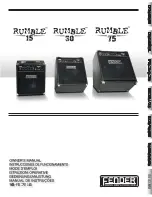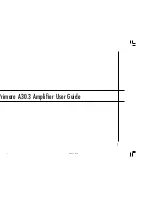
Operation Manual
CTs Multi-Channel Power Amplifiers
page 16
page 17
CTs Multi-Channel Power Amplifiers
Operation Manual
2. Hold the Reset/Preset switch in for two flashes of the Data light
(longer than 2 seconds).
3. The Data indicator will flash rapidly for a moment.
4. Restore the audio input signals.
To restore the unit including presets to factory default
settings:
1. Remove all audio input signals.
2. Hold the Reset/Preset switch while applying power to the unit.
3. The Data and Preset indicator will both light.
4. Release the switch within 5 seconds (before the Data and Pre set
indicators go out).
5. The Data indicator will flash rapidly for a moment.
6. Restore the audio input signals.
3.2.10 User Presets
The control settings for all the functions can be stored as presets.
A total of ten presets can be saved in the USP/CN’s nonvolatile
memory. Each preset can be named with a 30 character name
describing its function, which is also stored in the USP/CN’s
memory.
•
The
Store Preset Control
saves the current setting to the
specified preset.
•
The
Recall Preset Control
recalls the specified preset
set tings.
•
The
Preset Valid Monitor
indicates if a change has been
made to any setting since the last time a preset has be saved or
recalled.
•
The
Last Stored or Recalled Preset Monitor
indicates
what the Last Stored or Recalled preset is.
3.2.11 Clip Event Monitor
A clip detector is provided each channel. These monitors will
indicate any clip condition (> 0.05% distortion) in the amplifier
channel. The clip detectors also can indicate certain errors (See
Section 3.1.25).
3.2.12 Input Signal Level Monitor
The input signal level of each channel can be monitored via
Sys tem Architect software. The measurement range is from +20
dBu to –40 dBu with 0.5 dBu resolution. Each audio channel has
the following monitors:
• Analog audio input: The audio input at the Balanced Audio
Inputs.
• Switched audio input: The audio input after the Input Audio
Router.
• CobraNet audio input: The audio input level from the selected
CobraNet audio channel.
3.2.13 Output Signal Level Monitor
The output signal level of each channel can be monitored via
System Architect software. The measurement range is from 0 dB
to –40 dB with 0.5 dB resolution. The monitors are scaled so that
0 dB is referenced to the full rated output voltage of the amplifier.
3.2.14 Thermal Headroom Level Monitor
The thermal headroom level of each channel can be monitored
with the software. This level represents the percent of available
power/thermal capacity that is currently being used within the
output section of the amplifier. When the thermal headroom level
reaches 100%, the amplifier cannot produce any more power and
it will begin to protect the output devices by limiting their drive
level. The thermal limiter feature of the USP/CN can be set to
engage at a pre-selected thermal level. (See Section 3.2.31).
3.2.15 Power/Standby Control
Each channel can be independently turned on and off.
3.2.16 Signal Mute
The output signal of each channel can be independently muted.
This function produces a minimum 60 dB of attenuation.
3.2.17 Polarity Inverter
The input signal polarity of each channel can be independently
inverted.
3.2.18 Input Signal Fader
Each input signal can be adjusted under software control. The
gain range is +20dB to –100dB in 0.5 dB steps. Each analog
Audio Input has two faders with these functions:
• Trim the Analog Audio Input signal before the Input Router.
• Trim the Analog Audio Input signal after the Input Router.
3.2.19 Amplifier Information
At startup, the module extracts several useful items of informa tion
about the host amplifier. These include manufacturer, model, date
code, and serial number. This information is stored in the software
system inventory and is displayed on the software con trol panels.
3.2.20 User and Channel Labels
In IQwic, the module can store two user labels and channel labels.
In System Architect, the module can store 4 or 8 channel labels
and a unit label.These labels are 30-character strings that can be
set by the user to indicate the function of the amplifier and its
channels. For example, “LOWER RIGHT CLUSTER, FOR DELAY.”
3.2.21 Line Voltage Monitor
The AC line voltage supplied to the amplifier can be monitored with
this function. If the voltage is out of a safe area you can trigger an
error.
3.2.22 Error Reporting
The module can detect three different error conditions per channel
and errors in the AC line voltage. Each error type can be configured
to report the error through the control network and/or the AUX port.
Network reported errors appear in the control software’s Error
Win dow.
The software offer many options to further report errors, including
audible alerts, printout, email, pager, serial port and fax. The options
are set in the software. The following describes each error source.
CLIP:
The USP/CN can be configured to report if an excessive
number of clip events occur in either amplifier channel. The clip
events are consider an error if they exceed the defined count per the
defined unit of time. The
Count
Control sets the maximum number
of events before the error is reported. The range is 1 to 100. The
Time
Control defines the amount of time that the events are counted
before starting the counting process over. Its range is 1 to 10
seconds. Note: Clip events are defined as the start of each clip and
every 10 milliseconds the amplifier is in clip thereafter. Using a high
count setting with a short time setting may result in clip error never
being detected.
THERMAL:
Errors can be generated for excessive temperature in
the output section of the amplifier channel. The
Threshold
Control
sets the level that, if exceeded, will generate the error report. This
control has a range of 1 to 100%.
LOAD:
If the load monitoring feature is activated, an error report can
be generated if the load impedance moves outside the pre-selected
range. See Section 3.1.33 for instructions on setting up load
monitoring.
LINE VOLTAgE:
The AC line voltage can be monitored and an error
generated whenever the voltage is outside of the limits set at the
factory.
3 Operation
(continued)
3.2.23 Input Signal Compressor/Limiter
An input signal compressor/limiter is available for each channel.
Five parameters control this feature:
Enable:
Enables or disables this function.
Threshold:
Sets the level, in dBu, above which the compressor
begins to attenuate the input signal. This level corresponds to the
input level meter reading. The compressor is “feed-forward,”
meaning that the level detection point is located before the gain
control stage. The range is from +20 dBu to – 50 dBu.
Attack Time:
Sets the attack time of the compressor. The attack
time is defined as the time it takes the compressor to attenuate the
signal gain by 20 dB. The range is from 1 millisecond to 0.1
second.
Release Time:
Sets the release time of the compressor. The
release time is defined as the time it takes the compressor to
increase the signal gain by 20 dB. The range is from 10
millisec onds to 10 seconds.
Compression Ratio:
Sets the compression ratio of the
com pressor. The ratio is the relation between the amount of
attenua tion applied by the compressor verses the amount that the
input signal is over the threshold. The available settings are 2:1 to
32:1.
3.2.24 Peak Voltage Limiter
This limits the peak voltage output of the amplifier. Four
parame ters control this limiter for each channel:
Enable:
Enables or disables this function.
Threshold:
Sets the level, in absolute voltage, which the limiter
will allow from the amplifier. The range is from 12 V
pk
to 255 V
pk.
Attack Time
: Sets the attack time of the limiter. The attack time is
defined as the time it takes the limiter to attenuate the output
signal by 20 dB. The range is from 1 millisecond to 100
millisec onds.
Release Time:
Sets the release time of the compressor. The
release time is defined as the time it takes the limiter to increase
the output signal by 20 dB. The range is from 10 milliseconds to
10 seconds.
3.2.25 RMS Power Limiter
This limits the long-term output power of the amplifier. Four
parameters control this limiter for each channel:
Enable:
Enables or disables this limiter.
Threshold:
Sets the average power level, in watts, which the
limiter will allow from the amplifier channel. The range is from 10
watts to 600 watts. This level should be set to the connected
loudspeaker’s long-term power rating.
Attack Time:
Sets the attack time of the limiter. The attack time is
defined as the time it takes the limiter to attenuate the output
signal by 20 dB. The range is from 1 second to 30 seconds.
Release Time:
Sets the release time of the compressor. The
release time is defined as the time it takes the limiter to increase
the output signal by 20 dB. The range is from 1 second to 30
sec onds.
3.2.26 Load Supervision
The load supervision feature allows real-time monitoring of the
load connected to each amplifier channel. When enabled, the
USP/CN continuously monitors the amplifier output voltage and
current, and calculates the long-term average load impedance.
The measured load impedance is compared against the user-
defined high and low limits. If either limit is exceeded, the status
indicator and, if enabled, the System Architect Error Reporting
functions alert the user of the problem. There are six controls and
two indicators for each channel:
Enable:
Enables or disables the load-supervision function.
High Limit:
Sets the upper bound above which the system will
report a “high” error status.
Low Limit:
Sets the lower bound below which the system will
report a “low” error status.
Nominal Load Impedance:
Sets the expected average
imped ance for the connected load. This value determines the
output signal level required for the test. This parameter is also
used by the average power limiter to determine the expected
power threshold. (See Section 3.1.29).
Report Error to Network:
Enables Error Reporting to send an
error report via the network so that high and low load conditions
are reported to the software.
Report Error to Aux:
Enables and high or low load error to be
reported by the AUX output. (See Section 4.1.1).
Test Indicator:
This indicator is active when the amplifier out put
signal is sufficient to allow load impedance calculation and test
verification.
Low/Normal/High Indicator:
This indicator shows the present
status of the load impedance with respect to the user-defined high
and low limits.
Z Average Monitor:
Reports the actual calculated average load
impedance in ohms. Its range is from 0 ohms to 250 ohms.
Load Supervision Applications
The Load Supervision feature can be used to monitor the ampli fier
load in real time with almost any program material. Average load
impedance is calculated as a function of amplifier output voltage
and current. The system requires approximately 20-30 mA of
average amplifier output current for adequate supervision. This
allows typically low average output power levels of less than ½
watt with most loads. The maximum load impedance for reli able
system performance is limited to about 50 ohms. Higher
impedances can be measured but may require higher amplifier
output levels for reliable operation.
3 Operation
(continued)
Содержание CTs 4200USP/CN
Страница 23: ......









































